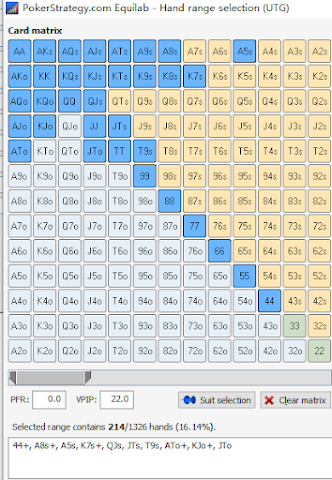Poker Dream Post-Tournament Review (Part two)
Poker Dream Post-Tournament Review (Part two)
Continuing from the previous article, this piece focuses on the strategic review following the Poker Dream 9 series.
Initially, I had set my hand range between 15%-17%,
Focusing primarily on the top range and foregoing marginal gains, I discarded hands that required intricate post-flop skills. However, widening my hand range could likely lead to higher returns and easier equity realization. This is because, given the level of play observed in these matches, my post-flop play tends to be superior to most competitors, making it easier to capitalize on my hands' equity.
After making adjustments, my hand range is expected to have an entry rate of around 23%.
In the periphery of my hand range, such as A8o and below, K6s and below, Q9s and below, the decision to play these hands depends on my position. The adjusted hand range requires an increased probability of bluffing and necessitates enhanced skills in reading the game post-flop, as well as the ability to make precise judgments on the fly. In tournaments with a weaker player pool, it's easier to realize equity and accumulate enough chips. My ability to accurately determine opponents' ranges makes decision-making comparatively straightforward, given the ample information available. A friend recently inquired about how I discern opponents' hand ranges, prompting this note.
Texas Hold'em tournaments are strategic games of multiplayer negotiation where players aim to maximize their benefits with minimal costs. Despite individual differences, strategies tend to converge towards an equilibrium for long-term profit. Factors such as a player's entry rate, shown hands, position, betting frequency, and bet sizes are crucial for deducing opponents' hand ranges. Understanding the likely hand ranges of opponents based on their actions and adapting one's strategy accordingly is essential. For instance, if an opponent frequently plays Ax hands from late positions and makes a small bet without an Ace on the flop, it might indicate they missed the board, guiding our response strategy.
Explaining the concept might seem complex, but it's actually not difficult; it just requires careful observation. Experienced players can typically gauge their opponents' ranges because everyone's aim is to win, not lose, making their ranges predictable. Similarly, my hand range can be predicted, and we can strategize around these expectations.
This leads to more advanced strategies, which I'll write about when there's time.
Overall, hand ranges should be moderately expanded to around 25%, with an ideal entry rate between 20% and 30%. It's important to remember that players in live tournaments generally aren't as strong as those in online competitions.
《poker dream 赛后检讨(二)》
文接上篇。
2. 手牌范围
本次的Poker Dream 9 我的预设手牌范围在15%-17%左右,大概是长这样:
主要集中顶部范围,放弃边际收益,翻牌后需要较多技巧的手牌我都放弃了。但实际效果来说,适当放宽手牌范围应该会有较高收益,equity实现比较容易。原因是根据这些场次的比赛来看,翻牌后的处理我应该要优于大部分玩家,实现权益比较容易。
调整后的手牌范围大概会有23%左右的入池率:
再边缘的手牌比如A8o以下,K6s以下,Q9s以下等,会看位置决定。调整后的手牌范围需要增加诈唬概率,需要更多翻牌后的阅读比赛能力,以及需要对场上的精确判断能力。但是在玩家池较弱的赛事会比较轻松实现equity,累积足够筹码。
从实际赛场来看,我抓对手范围还是比较精确的,那做决策相对来说比较容易,资讯比较充足。刚好刚才有朋友问我怎么抓对手范围,就顺便记录一下。
德州扑克比赛是一个多人博弈的策略游戏。那按照最基本的博弈理念,所有玩家都希望用最小的成本换取最大的利益。所以就算每个玩家的个性不同,他们的策略最终都会倾向于均衡策略,以实现长期盈利的目标。那玩家的入池率,玩家曾经展示过的手牌,玩家的位置,下注频率,下注尺寸,这些都是判定对手范围的依据。上面那张图其实就是一个参考表。在入池率大约30%左右的玩家大概会有什么样的范围,20%左右会有什么范围,15%有什么范围,我都可以判定的出来。那我们有了对手大致的范围,以我们手牌的范围,如何对抗对手,这就是这个游戏的精髓了。比如我大致知道某个玩家在后位喜欢玩更多的Ax,因为他曾经在这个位置展示过Ax的手牌,那在他同样位置入池的时候,他很大可能是Ax的手牌。那如果flop并没有A,而他下小注,我们大概可以判断出他没中任何牌,那我们就可以有相对应的决策。
当然解释起来很复杂,其实并不难,只需要仔细观察,我相信大部分老手大概都可以抓到对手的范围。因为所有玩家都希望赢,不希望输,那他们的范围就可以被预测。同样的,我的范围也可以被预测,那我们也可以通过这种被预测的范围做文章。
这就牵涉到更加深入的博弈了,有空再写。
总体来说,手牌范围应该适度放宽到25%左右,误差不应该超过5%,也就是20%-30%左右的入池率是比较理想的。
现场比赛的玩家池普遍要弱于网上比赛的玩家,这点要记住。




Comments
Post a Comment